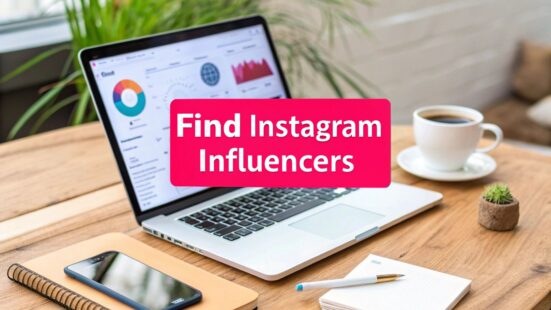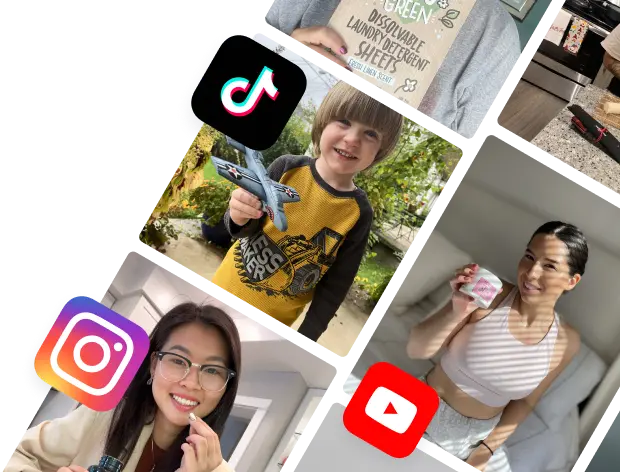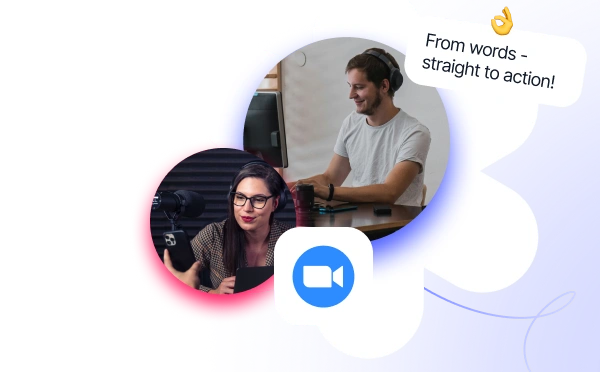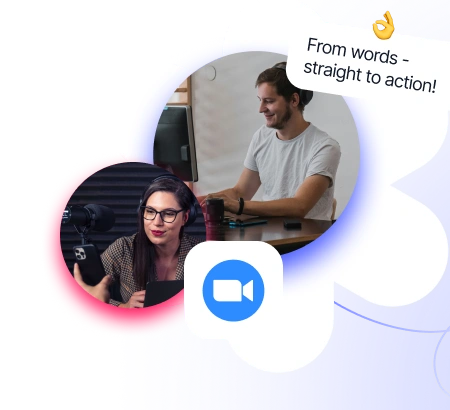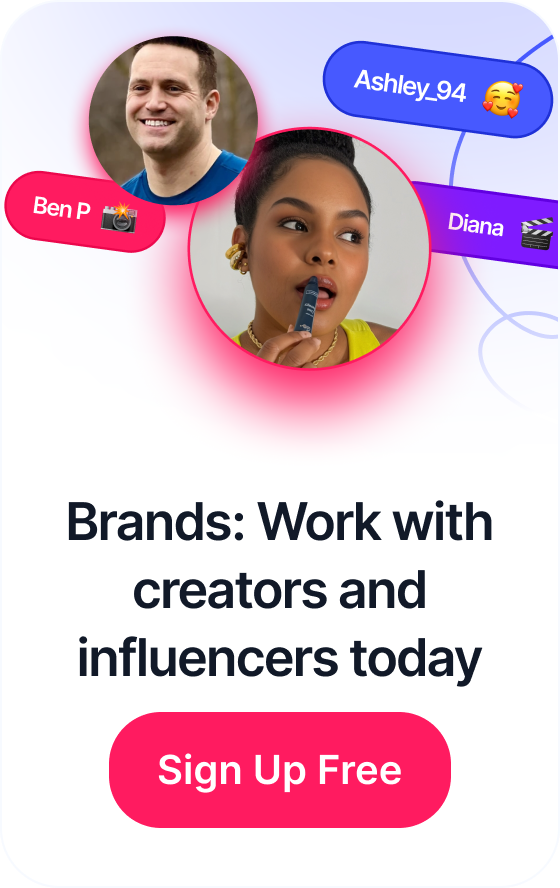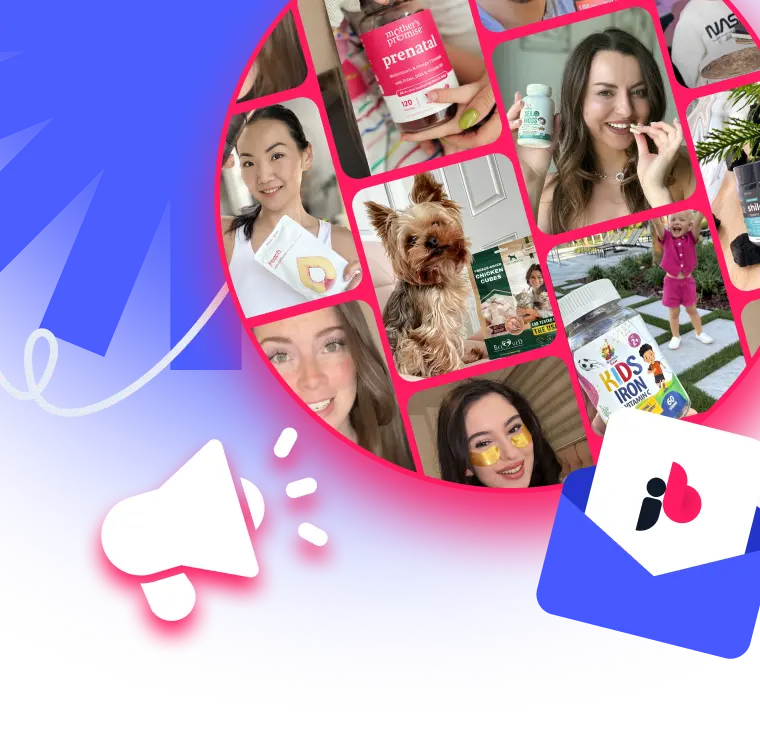 7 Powerful User-Generated Content Examples for 2025
7 Powerful User-Generated Content Examples for 2025
Before you even think about scrolling through Instagram to find influencers, you need to do the real work. It all starts with a solid plan—not just a vague idea, but a concrete strategy. This means nailing down your campaign goals, getting crystal clear on your target audience, and figuring out a budget that makes sense.
This prep work is what separates a killer campaign from one that just burns through cash.
Table of Contents
Setting the Stage for a Successful Influencer Search
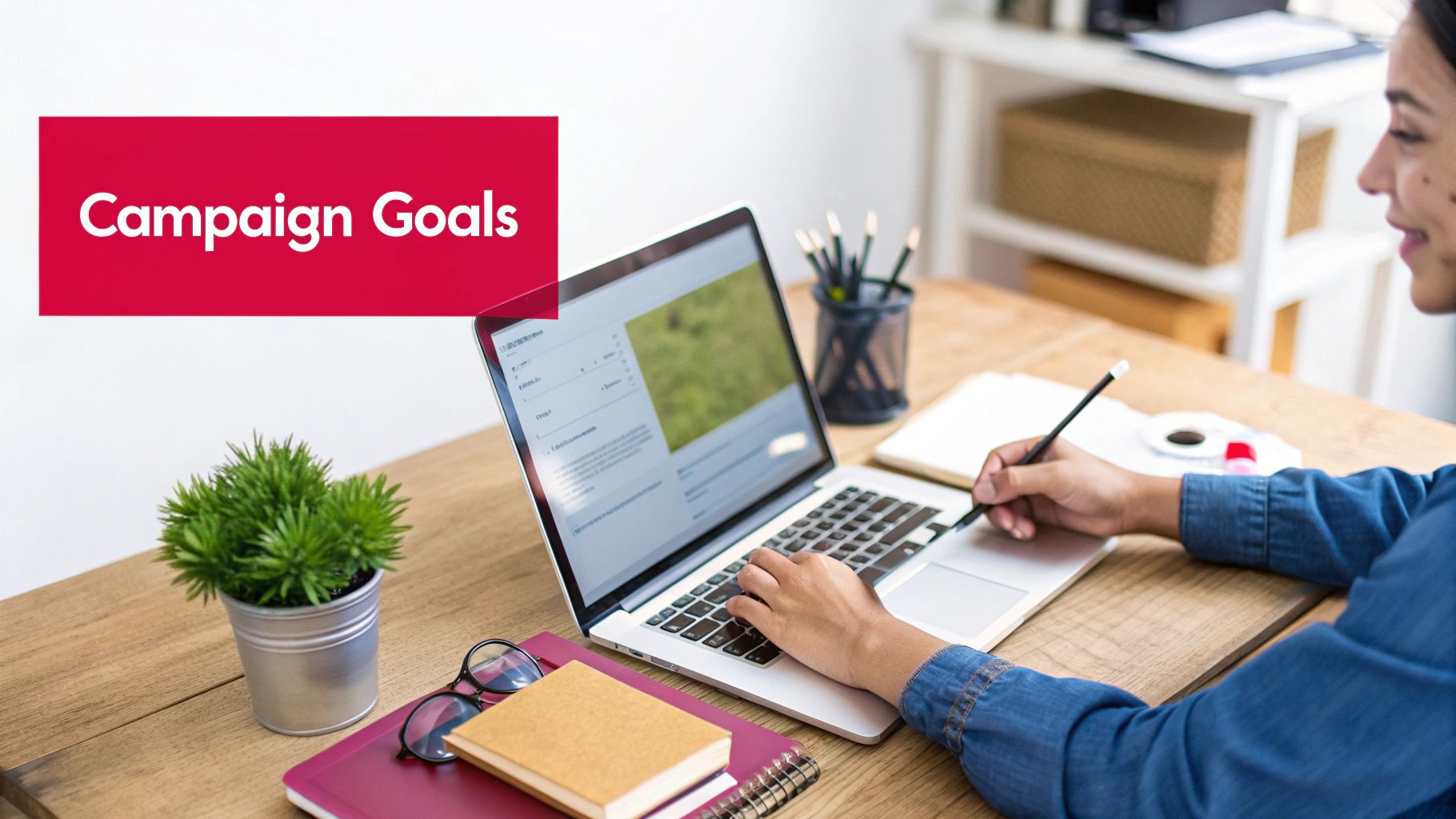
Seriously, don't even open the app yet. Diving into the search without clear goals is like wandering into a massive store without a shopping list. You’ll grab a bunch of stuff that looks cool, but you'll get home and realize none of it is what you actually needed. The planning phase is where you build the foundation for a partnership that actually moves the needle.
The influencer marketing world is massive and still growing, expected to hit $32.55 billion by 2025. That's a lot of noise. A meticulous approach is the only way to cut through it. And the payoff is real—businesses are seeing an average return of over $6 for every $1 spent. But that kind of ROI doesn't happen by accident. It happens with a plan.
Define Your Campaign Goals
First things first: What are you actually trying to accomplish? "Brand awareness" is not a goal; it's a wish. You need to get specific and attach numbers to your objectives. This is the only way you’ll know if your campaign was a success.
Think about how an influencer partnership can help you grow social media followers and what that really means for your business.
Here are a few examples of what real goals look like:
- Driving Sales: Maybe you want to move a specific product. A solid goal would be: "Achieve a 3x ROAS from influencer discount codes in the first 30 days."
- Generating Leads: Looking to build your email list? Try this: "Acquire 500 new email subscribers through an influencer-hosted giveaway."
- Boosting Visibility: If you truly are focused on reach, quantify it. For example: "Reach 250,000 users in our target demographic via influencer Story mentions this quarter."
Setting concrete, trackable goals gives you a roadmap. It not only points you toward the right kind of influencers but also gives you a clear way to measure the impact once everything is said and done.
Profile Your Ideal Customer and Audience
Okay, goals are set. Now, who are you talking to? It's completely useless to partner with an influencer who has a million followers if none of them are your people. You need to build a detailed persona for your ideal customer.
Go beyond the basics like age and location. Dig into the psychographics—what do they care about? What are their hobbies, their values, their biggest challenges? Where do they hang out online when they’re not on Instagram?
When you have this level of detail, you can find creators whose audience is a direct reflection of your ideal customer. That’s when the magic happens, and your message actually feels authentic and hits home.
Effective Methods to Discover Instagram Influencers
Alright, you’ve got your goals and your ideal customer in mind. Now for the fun part: the actual hunt for the right influencers.
Knowing where to look is half the battle. You can find incredible talent by digging around on Instagram yourself, keeping a close eye on your competition, or using specialized platforms designed to make this whole process way faster.
Each approach has its perks, depending on your budget and how much time you have. The real secret? Don't put all your eggs in one basket. A mix of these strategies will help you uncover creators you’d never find otherwise.
Manual Discovery on Instagram
The most straightforward way to find influencers is to just use Instagram itself. It’s a hands-on method that forces you to think like your target customer, showing you exactly who they’re already following and listening to. It can feel like a bit of a treasure hunt, but the people you find this way often feel the most authentic.
A great starting point is searching for hashtags that are relevant to your niche. Don't just stick with the obvious ones like #fitness. Go deeper. Think about the tags that signal a real community, like #veganmealprep or #sustainablefashionblogger. These will lead you straight to the creators who are already at the heart of the conversations you want to join.
You can also use location and brand tags to your advantage:
- Location Tags: Search for places where your ideal customers hang out. This could be a local coffee shop, a popular hiking trail, or a specific city. You'll quickly find local influencers who have a really dedicated following in that area.
- Brand Tags: Take a look at who's tagging brands similar to yours—or even your direct competitors. This is a goldmine for finding creators who are already passionate about your industry.
Analyze Your Competitors' Collaborations
One of the smartest shortcuts is to see who your competitors are already working with. If an influencer is successfully promoting a similar product, there’s a good chance their audience is a perfect match for your brand, too. This is a fantastic way to find talent that’s already been proven to get results in your space.
Jot down a list of your top three to five competitors and do a little digging on their Instagram profiles. Look for posts where they’re tagged or mentioned, and pay special attention to anything marked as a paid partnership. This gives you a pre-vetted list of creators you can investigate further.
Here's a pro tip: Don’t just copy your competitors’ influencer roster. Use their strategy as inspiration. Are they mostly working with micro-influencers who have sky-high engagement? Or are they going after bigger names with a massive reach? Understanding their approach can help you sharpen your own.
Use an Influencer Marketing Platform
Let’s be real—manual searching works, but it can eat up a ton of time. This is where influencer marketing platforms really shine. These tools are built specifically to speed up your search for Instagram influencers, giving you powerful filters you just can't get inside the app.
This chart gives a pretty good idea of how these different discovery methods stack up. As you can see, a balanced approach is usually the most effective.
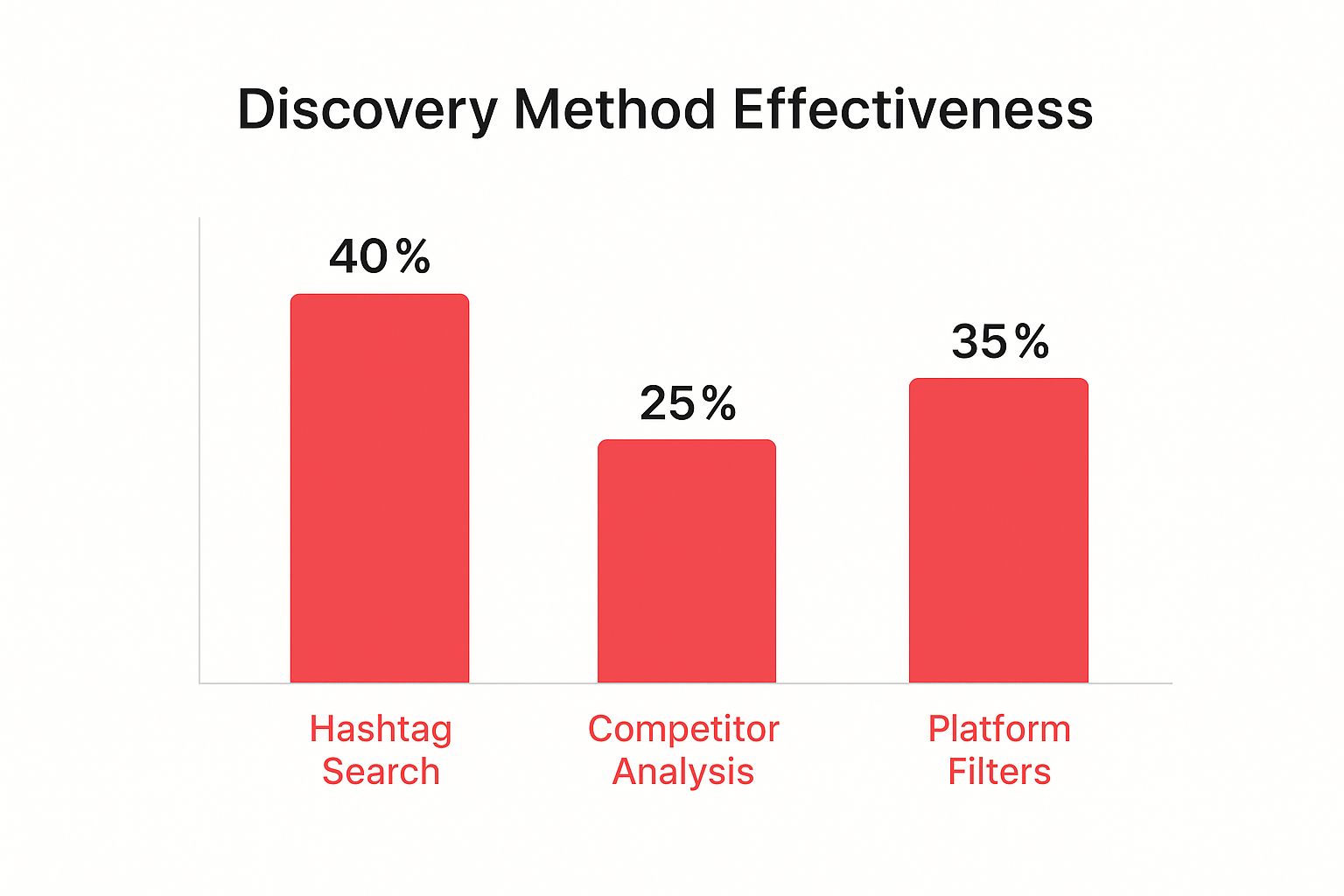
While manual searches are still incredibly valuable, platform filters are a close second and a non-negotiable part of any modern strategy.
Tools like JoinBrands let you slice and dice your search by niche, engagement rate, audience demographics, and even past collaborations. This is huge, especially when you consider that 43.74% of influencer audiences are in the 25-34 age range. With 79% of marketers saying Instagram is essential, you need tools that help you hit that sweet spot.
You can check out more about these influencer marketing platforms to see which one might be the right fit. Having all that audience data upfront saves you countless hours of vetting and lets you build a killer list of potential partners right from the start.
How to Vet Influencers and Spot Red Flags
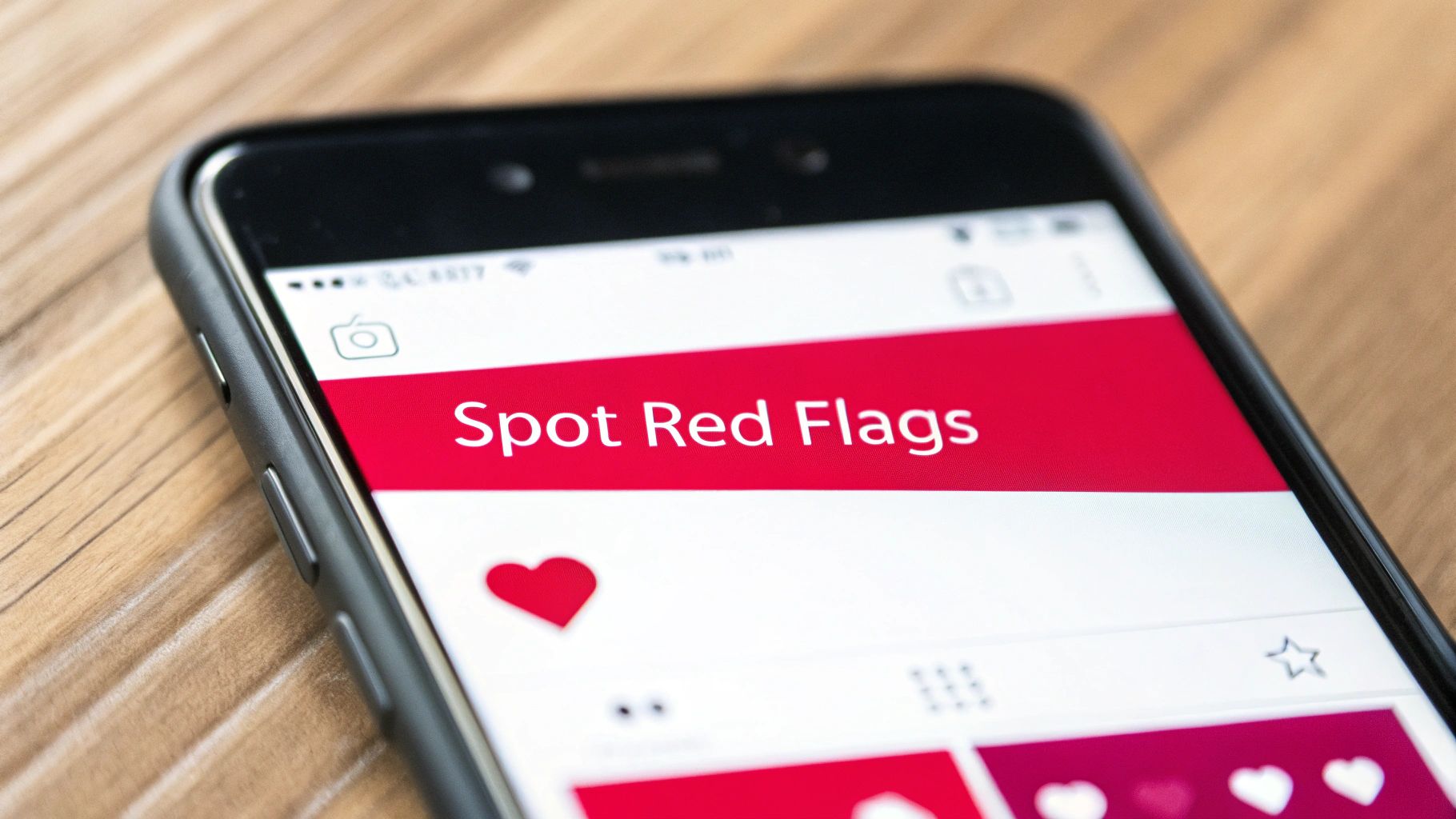
Finding a creator with a big follower count feels like a win, but honestly, that’s just the starting line. Real influence isn't about the size of their audience; it's about the quality of their community.
This is where the real work begins. Vetting is how you look under the hood to make sure a potential partner has genuine credibility and an audience that actually listens. It's your best defense against wasting your budget on inflated numbers and fake engagement.
Key Influencer Vetting Criteria
Before diving into the specifics, it helps to have a clear checklist. This table breaks down the essential metrics you should be looking at to separate the authentic creators from the pretenders.
| Metric | What to Look For | Red Flag |
|---|---|---|
| Engagement Rate | A healthy percentage of likes, comments, and shares relative to their follower count. | Abnormally low interaction on posts despite a massive follower count. |
| Audience Quality | Follower profiles look like real people with posts, profile pics, and normal bios. | A large number of followers with no posts, generic usernames, or no profile picture. |
| Comment Authenticity | Genuine questions, thoughtful responses, and real conversations in the comments. | Spammy, one-word comments ("Nice!") or an endless stream of emoji-only replies. |
| Follower Growth | Steady, organic growth over time. | Sudden, massive spikes in followers overnight, indicating purchased bots. |
| Content Alignment | Their aesthetic, tone, and values genuinely match your brand's identity. | A jarring mismatch in style; promoting competing brands too frequently. |
| Sponsored Post Quality | Paid partnerships are integrated naturally and creatively into their feed. | Posts that feel like generic, copy-pasted ads with no personal touch. |
Think of these criteria as your compass for navigating the vetting process. A creator who ticks all the right boxes is far more likely to deliver real value for your brand.
Analyze Engagement Beyond the Likes
A massive follower count means nothing if nobody is paying attention. The first and most critical metric to check is the engagement rate. This simple number reveals what percentage of an influencer's audience actually interacts with their content—the likes, comments, shares, and saves.
A healthy engagement rate is a sign of a loyal and genuinely interested community. On the other hand, a low rate on an account with hundreds of thousands of followers is a huge red flag. It often points to a ghost town of purchased followers or a completely checked-out audience. To get a better handle on the numbers, you can dig into the Instagram engagement rate formula and see what industry benchmarks look like.
Don’t just glance at the numbers; read the comments. Are people asking real questions and leaving thoughtful compliments? Or is it a wasteland of generic "Nice!" comments and random emojis? Authentic engagement sparks real conversation.
Scrutinize Audience Authenticity
Once you've confirmed their engagement seems legit, it's time to verify that their audience is real—and that they’re your people. Fake followers and bot activity are everywhere, and partnering with an influencer who has a padded account is like renting a billboard in an empty desert.
Here are a few tell-tale signs of a fake following to watch out for:
- A Sketchy Follower-to-Following Ratio: Look at the profiles of their followers. If you see tons of accounts that follow thousands of people but have very few followers themselves, those are likely bots.
- Sudden Growth Spikes: Use a social analytics tool to chart their follower growth. A sudden, unnatural jump of thousands of followers in a single day almost always means they bought them.
- Low-Quality Follower Profiles: Do a spot-check. Click on a dozen or so of their followers. A high number of accounts with no profile picture, zero posts, and a username made of random numbers is a dead giveaway.
Evaluate Content Quality and Brand Alignment
Finally, step away from the numbers and do a qualitative gut check. Does this influencer’s content style, tone, and overall vibe actually feel like a fit for your brand? The best partnerships feel natural and authentic, never forced.
Scroll through their past sponsored posts. Do they weave products into their content seamlessly, or does it stick out like a sore thumb? An influencer who promotes a different random product every other day likely has an audience suffering from ad fatigue.
The best creators are selective. They only partner with brands they truly believe in, which makes their recommendations carry so much more weight with their audience. That’s the kind of partner you’re looking for.
Crafting Outreach That Actually Gets a Response

You’ve done the hard work and narrowed down your list of dream creators. Now comes the moment of truth: reaching out. This is exactly where so many brands stumble. A generic, copy-pasted DM is the fastest ticket to being ignored, deleted, or just plain lost in a sea of other low-effort pitches.
Your first message sets the entire tone for a potential partnership. It has to feel personal, look professional, and instantly show the influencer you’ve actually done your homework. Creators are running a business, after all, and they can spot a mass-messaged template from a mile away.
The Art of the Personalized Pitch
The only way to stand out is to show you’re genuinely interested. Before you even think about hitting "send," warm up the introduction by engaging with their content for a few days. Like a few posts, leave a thoughtful comment, maybe reply to one of their Stories. When your message finally lands, it won't be from a total stranger.
When you do slide into their DMs or send that first email, prove you're a real fan. Reference a specific post, Reel, or Story that you actually enjoyed.
- Don't do this: "Hey, love your page! Let's collab."
- Do this instead: "Hi Alex, I loved your recent post on sustainable coffee brands. The way you explained the sourcing process was super insightful!"
That simple bit of personalization shows you respect their craft and aren’t just blasting out hundreds of identical messages. It tells them you see them as a unique creator, not just another name on a spreadsheet.
How to Structure Your Message
A great outreach message is clear, concise, and—most importantly—creator-focused. It needs to immediately answer the "What's in it for me?" question from their perspective.
A winning message usually has four key parts:
- A Personalized Opening: Like we just covered, kick things off with a specific compliment about their work.
- A Quick Intro: Briefly introduce your brand and what you do. Keep it tight—one sentence is perfect.
- The Value Proposition: Explain why you think a partnership makes sense. What's the mutual benefit here?
- A Simple Call to Action: Don't overwhelm them with details. Just suggest a clear next step, like sending more info via email or hopping on a quick call.
Your first DM isn't the place to send a full campaign brief. The only goal is to start a conversation and get a "yes" to learning more. Keep it short, respectful, and intriguing.
With an estimated 63.8% of brands planning influencer partnerships in 2025, a polished approach is no longer optional—it's essential for cutting through the noise.
Following Up Like a Pro
If you don't get a reply right away, don't panic. Influencers are incredibly busy people. It’s perfectly acceptable to send a single, polite follow-up after about a week. A gentle nudge can be all it takes to bring your message back to the top of their inbox.
Once you’ve made contact and agreed to a collaboration that involves sending products, having a smooth process is critical. Make sure your logistics are just as professional as your outreach. To nail this part, check out our guide on how to send products to influencers. This kind of attention to detail is what builds the foundation for a strong, lasting partnership.
Managing and Measuring Your Campaign for Success
Getting a "yes" from the perfect influencer feels like crossing the finish line, but really, it’s just the starting gun. A successful collab doesn't just happen. It's built on clear communication, smooth processes, and—most importantly—knowing your numbers. This is how you stop hoping for a good return and start proving it.
First things first: you need a rock-solid creative brief. This document is your campaign’s blueprint. It should spell out everything from key talking points and content deliverables to deadlines and FTC disclosure rules (like always using #ad). Don't think of it as a list of demands; it's a guide to get everyone on the same page.
Without a solid brief, you’re basically just winging it. A good one gives the creator enough direction to nail your brand's message while leaving them the creative space to be themselves. That's the sweet spot where content truly connects with their audience.
Tracking the Metrics That Matter
Once the content is live, your job pivots entirely to tracking. Sure, clicks and impressions look nice on a report, but they don't paint the full picture. To really see the impact, you have to measure the actions that actually drive your business forward.
This isn’t optional. A data-first mindset is what separates a one-off promotional post from a scalable, long-term influencer strategy.
Here are the essential tracking methods you should have in place:
- UTM Parameters: These are little bits of code you add to your links that tell your analytics exactly where your traffic is coming from. Give each influencer their own unique UTM link, and you'll see precisely how many website visits and conversions their posts are generating. Simple and effective.
- Unique Discount Codes: For e-commerce brands, this is one of the cleanest ways to attribute sales. A custom code like "SOPHIA15" is easy for customers to remember and even easier for you to track. You’ll know down to the dollar how much revenue a specific influencer drove.
- Affiliate Links: This takes things a step further. Affiliate links can track both clicks and sales, but they can also automate commission payouts to the creator. It’s a win-win for performance-based partnerships where everyone is motivated to drive results.
Your campaign data is a goldmine. It tells you which creators are driving real results and what kind of content connects with your target audience, informing every future decision you make.
Analyzing and Reporting on Performance
With your tracking systems humming along, the final piece of the puzzle is analysis and reporting. You need to pull all that data together to see the big picture. How did the campaign stack up against your initial goals? What was the engagement rate on the sponsored posts? And the big one: what was the final return on ad spend (ROAS)?
To really get a handle on the performance of your influencer collaborations, it’s worth exploring different social media reporting tools. These platforms can automate the grunt work of data collection and serve up insights in a way that’s easy to understand, saving you from hours buried in spreadsheets. The intel you gather here will sharpen your process for the next time you set out to find Instagram influencers, making sure every campaign is smarter than the last.
Common Questions About Finding Influencers
Stepping into the world of influencer marketing can feel like you're learning a whole new language. As you start looking for Instagrammers to partner with, it's totally normal to have a ton of questions—everything from "How much is this going to cost?" to "What are the legal rules?"
Getting these details right is just as critical as finding the perfect creator for your brand. Let's walk through some of the most common hurdles I see brands run into. Think of this as your practical, no-fluff guide to clearing those hurdles with confidence.
How Much Does It Cost to Hire an Instagram Influencer?
Honestly, there's no single price tag. It’s the classic consultant’s answer: "It depends." Influencer costs can swing wildly based on everything from their follower count and engagement rate to their specific niche and what you're actually asking them to do.
But to give you a clearer picture, here’s a general ballpark:
- Nano-influencers (1k-10k followers): These creators are often happy to collaborate for free products. If they do charge, it's usually not much—think up to $100 per post. What you get in return is often sky-high engagement in a super-specific niche.
- Micro-influencers (10k-100k followers): This is the sweet spot for a lot of brands. Rates here typically fall somewhere between $100 and $500 a post.
- Mid-tier and Macro-influencers (100k+ followers): Prepare for the costs to jump. We're talking thousands of dollars per post, sometimes more, depending on their celebrity status and reach.
The real pro tip? Negotiate based on the value and potential ROI they bring, not just their follower count. A smaller creator with a fiercely loyal, engaged community can often drive more sales than a massive account with a passive audience.
What Are the Essential FTC Guidelines?
This one is non-negotiable. The Federal Trade Commission (FTC) has crystal-clear rules about transparency, and ignorance isn't an excuse. Both you and the influencer are on the hook for following them, so you absolutely need to know the basics.
The core rule is simple: any "material connection" must be clearly and conspicuously disclosed. In plain English, if you're paying them or even just giving them free stuff, they have to tell their audience. That means using unambiguous hashtags like #ad or #sponsored right at the beginning of the caption—not buried in a sea of 30 other tags at the very end.
What to Do If a Campaign Underperforms?
It happens. Not every influencer campaign is going to knock it out of the park. But an underperforming campaign isn't a failure; it's a lesson. The first thing to do is take the emotion out of it and dive straight into the data.
Try to figure out what went wrong. Was the call-to-action confusing? Did the content just not land with their specific audience? Maybe the timing was off? Look back at your original vetting process, too. You might spot a small red flag you missed the first time around. Use every insight to sharpen your strategy and make the next campaign even better.
Ready to streamline your search and connect with authentic creators? JoinBrands offers a powerful platform to discover, manage, and measure your influencer campaigns all in one place. Find your perfect match today at https://joinbrands.com.
